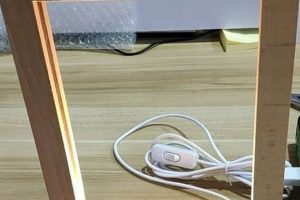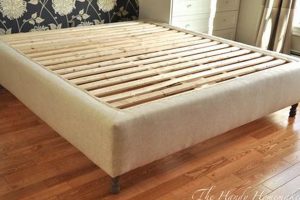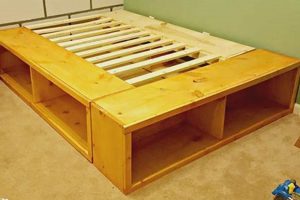A self-assembled, expansive border constructed from readily available materials serves to showcase art, photographs, or mirrors. An example includes utilizing lumber purchased from a local hardware store, cut and joined to specific dimensions to accommodate a sizable canvas.
The significance of crafting enclosures of this magnitude lies in the cost savings compared to professional framing services and the customization options available. Historically, artisans and hobbyists have employed similar techniques to exhibit their work or embellish their living spaces, reflecting a blend of practicality and personal expression.
Subsequent sections will detail the materials required, the construction process, and various finishing techniques applicable to these custom-built displays.
Construction Considerations
The following points are essential for achieving structural integrity and aesthetic appeal when building enclosures of significant size.
Tip 1: Material Selection: Opt for kiln-dried lumber to minimize warping and twisting. Softwoods like pine are economical, but hardwoods such as poplar or oak offer increased durability and a finer finish.
Tip 2: Accurate Measurements: Precise measurements are crucial. Employ a steel ruler and a combination square for accurate cuts. Double-check all dimensions before commencing assembly.
Tip 3: Strong Joinery: Mitered corners reinforced with wood glue and corner clamps provide a seamless appearance. Pocket-hole joinery offers additional strength, particularly for larger dimensions.
Tip 4: Adequate Support: For substantial sizes, consider adding internal bracing. A central support or crossbars can prevent sagging and maintain structural integrity over time.
Tip 5: Proper Surface Preparation: Sand all surfaces thoroughly, progressing from coarse to fine grit sandpaper. This ensures a smooth base for paint or stain application.
Tip 6: Secure Mounting Hardware: Select appropriate hanging hardware based on the weight of the finished piece. D-rings and picture wire are suitable for lighter items, while heavy-duty Z-clips offer greater support for larger and heavier constructions.
Tip 7: Consider the Reveal: The reveal refers to the amount of the artwork obscured by the frame. Plan the dimensions of the inner edge accordingly, ensuring it complements, rather than detracts from, the art it contains.
Adhering to these recommendations will contribute to a robust and visually pleasing outcome. Attention to detail during each stage of construction is paramount.
The subsequent sections will explore finishing techniques and alternative construction methods.
1. Material Selection
The selection of appropriate materials is paramount to the structural integrity, longevity, and aesthetic appeal of self-constructed, expansive enclosures. The choice directly influences the project’s difficulty, cost, and final appearance.
- Wood Species and Properties
The selection of wood species dictates the frame’s strength, weight, and visual texture. Softwoods, such as pine, are cost-effective and easy to work with but may lack the rigidity required for larger dimensions. Hardwoods, like oak or maple, offer superior strength and resistance to warping, but they necessitate more specialized tools and techniques for cutting and joining. The wood’s grain pattern also contributes significantly to the aesthetic, ranging from the subtle lines of maple to the pronounced patterns of oak.
- Dimensional Lumber vs. Specialty Wood
Dimensional lumber, readily available at most hardware stores, provides a consistent and predictable material for frame construction. However, specialty woods, such as reclaimed lumber or exotic hardwoods, introduce unique character and visual interest. Reclaimed lumber offers an environmentally conscious option, while exotic woods introduce distinct textures and colors. The choice depends on the desired aesthetic and the project’s budget.
- Fasteners and Adhesives
The selection of fasteners and adhesives impacts the joint strength and long-term stability of the frame. Wood screws offer robust holding power, while nails provide a faster assembly option. Wood glue is essential for creating strong, seamless joints, particularly with mitered corners. The choice of adhesive should be compatible with the selected wood species to ensure optimal bonding.
- Surface Treatment Materials
The selection of paints, stains, and sealants determines the frame’s final appearance and its resistance to environmental factors. Paints provide a wide range of color options and can offer protection against moisture and UV damage. Stains enhance the natural wood grain and provide a more traditional aesthetic. Sealants protect the wood from moisture, preventing warping and decay. The choice of surface treatment should complement the selected wood species and the desired aesthetic.
These material considerations collectively define the overall quality and visual impact of the finished self-constructed border. Thoughtful material choices enhance the display, while ill-considered selections compromise structural integrity and visual appeal.
2. Dimensional Accuracy
Dimensional accuracy is paramount in the construction of expansive self-assembled borders. The cumulative effect of even minor inaccuracies in individual component measurements can manifest as significant discrepancies in the overall dimensions of the finished piece. This can lead to visible distortions, instability, and difficulties in accommodating the intended artwork or object. For example, if each side of a large rectangular frame is off by even 1/16 of an inch, the total size discrepancy could be 1/4 inch, potentially causing the artwork to fit improperly or require modification.
The importance of dimensional precision increases exponentially with size. A smaller, less expansive structure might tolerate minor errors without significant detriment to structural integrity or aesthetic appeal. However, as the dimensions increase, these small errors compound, amplifying their impact. This principle is exemplified in mitered corners: if the angles are not precisely 45 degrees, the resulting corner joint will exhibit a visible gap or misalignment. For substantial constructions, the cumulative effect of these misaligned corners results in a frame that is not square, rendering it visually unappealing and structurally unsound.
In conclusion, achieving dimensional accuracy in DIY construction of large frames necessitates meticulous measurement, precise cutting techniques, and careful assembly. Failure to prioritize accuracy can result in a flawed final product, undermining the project’s intended purpose. Understanding this connection is crucial for any individual undertaking such a project, as it emphasizes the value of careful planning and execution from the outset, ensuring a professional-quality result and minimizing potential complications during assembly.
3. Joint Strength in Self-Constructed Expansive Borders
Joint strength is a critical determinant of structural integrity and longevity in self-constructed expansive borders. As size increases, stress on joints magnifies, necessitating robust construction techniques to prevent failure.
- Mitered Corners and Reinforcement
Mitered corners, common for aesthetic appeal, inherently lack surface area for strong adhesion. Reinforcement methods, such as splines, biscuits, or metal fasteners, become crucial. Failure to reinforce these corners in a DIY large frame often leads to separation at the joints, compromising structural stability and visual appearance. For example, a large frame without proper corner reinforcement might sag or break under its own weight or the weight of the artwork it contains.
- Wood Glue Selection and Application
The type of wood glue and its application technique significantly affect joint strength. Polyvinyl acetate (PVA) glues are suitable for general woodworking, while polyurethane glues offer superior water resistance and gap-filling properties. Proper clamping during the curing process is essential to ensure optimal adhesion. Insufficient glue or inadequate clamping can result in weak joints prone to failure, particularly in larger DIY structures. Consider the difference between a basic wood glue and epoxy, the latter being more reliable for strong joints with added costs.
- Mechanical Fasteners: Screws vs. Nails
Mechanical fasteners provide supplemental strength to glued joints. Screws offer greater holding power compared to nails, especially when driven into hardwoods. Pre-drilling pilot holes is recommended to prevent wood splitting, which weakens the joint. The choice of fastener depends on the wood species and the anticipated load on the frame. For expansive projects, screws are generally preferable for their superior strength and ability to be tightened if needed.
- Joinery Techniques Beyond Basic Butt Joints
Basic butt joints, where two pieces of wood are simply glued together, are inherently weak and unsuitable for large, self-assembled borders. More advanced joinery techniques, such as mortise and tenon, dovetail, or rabbet joints, offer significantly increased surface area and mechanical interlocking, resulting in stronger and more durable connections. While these techniques require more skill and specialized tools, their implementation is often necessary to achieve the required joint strength for a robust DIY large frame.
The effectiveness of the joints directly dictates the overall durability and visual quality. Employing suitable techniques and proper reinforcement directly translates to an expansive border that can reliably support itself and its contents for an extended duration, emphasizing the inextricable link between joint integrity and the overall success of the project.
4. Support Structure in Self-Constructed Expansive Borders
In the realm of self-constructed expansive borders, the support structure constitutes a critical element, directly influencing the frame’s structural integrity and longevity. As the dimensions of the frame increase, the inherent weight of the materials, combined with the added load of the artwork or mirror it houses, places significant stress on the frame’s joints and overall form. Without adequate support, the frame is prone to sagging, warping, or even catastrophic failure. For instance, a large frame constructed from lightweight wood spanning several feet in width necessitates internal bracing to prevent deflection in the center, which could lead to distortion of the displayed artwork or separation of the frame’s corners.
The implementation of a robust support system can manifest in various forms. Crossbars, strategically positioned across the frame’s interior, distribute the load and prevent sagging. Corner braces reinforce the joints, mitigating the risk of separation due to stress. Furthermore, the choice of materials plays a crucial role; denser hardwoods offer superior inherent support compared to softer woods, although they may present challenges in terms of weight and workability. The design of the support structure must also consider the intended mounting method. Frames suspended from a single point require a different support configuration than those mounted along multiple points to ensure even weight distribution and prevent undue stress on any single area.
In conclusion, the successful construction of a durable and visually appealing self-constructed expansive border hinges on the integration of an effective support structure. Neglecting this aspect invariably leads to structural instability and premature failure. A comprehensive understanding of load distribution, material properties, and appropriate support techniques is therefore essential for any individual undertaking such a project. Ultimately, the investment in a well-designed and executed support system ensures the longevity and aesthetic preservation of the framed artwork, highlighting the symbiotic relationship between support and the overall success of the endeavor.
5. Surface Preparation for DIY Large Frames
Surface preparation is a critical precursor to achieving a professional-quality finish on a do-it-yourself large frame. The absence of proper preparation directly impacts the adhesion of paint, stain, or other protective coatings, leading to premature peeling, uneven coloring, and a generally substandard appearance. For instance, if raw lumber is not adequately sanded, the resulting frame will exhibit a rough texture that detracts from the artwork it contains. Imperfections such as splinters, dents, or glue residue become amplified under a coat of paint, undermining the aesthetic intent of the project. Consider a frame constructed from reclaimed wood; without thorough cleaning and sanding to remove old finishes or contaminants, the new coating may react adversely, resulting in discoloration or a compromised bond. Therefore, meticulous surface preparation is not merely an optional step but an essential foundation for a successful outcome.
The specific techniques employed during surface preparation depend on the material from which the frame is constructed. For wood, this typically involves sanding with progressively finer grits of sandpaper to create a smooth, even surface. Filling any nail holes or imperfections with wood filler ensures a uniform substrate. For metal frames, surface preparation may involve degreasing, rust removal, and the application of a primer to promote paint adhesion. Failure to adequately prepare a metal surface can result in paint chipping and corrosion. Similarly, for frames constructed from composite materials, manufacturers’ recommendations regarding surface preparation should be strictly adhered to, as improper treatment can compromise the material’s integrity. The appropriate application of these techniques is crucial for optimizing the aesthetic and protective qualities of the finishing coat.
In summary, surface preparation directly influences the final appearance and longevity of a do-it-yourself large frame. The challenges associated with achieving a flawless finish are often directly attributable to inadequate attention to surface preparation. A thorough understanding of the materials involved and the appropriate preparation techniques is crucial for realizing a professional-quality result and ensuring the long-term preservation of the frame and its contents. By prioritizing this often-overlooked step, individuals can significantly enhance the aesthetic value and durability of their projects, ultimately contributing to a more satisfying and enduring outcome.
6. Hanging System
The selection and implementation of a suitable hanging system are integral to the successful display of a do-it-yourself large frame. The expansive dimensions and potentially substantial weight of such frames necessitate a robust and reliable suspension method to ensure both the aesthetic presentation and the physical safety of the installation. A poorly chosen or improperly installed hanging system can result in the frame’s detachment from the wall, causing damage to the frame, the artwork it contains, and potentially the surrounding environment. For example, attempting to suspend a large, heavy frame using only a thin wire and small nails is a scenario likely to result in failure. The forces exerted on the hanging points can exceed the wire’s tensile strength or the nails’ holding power, leading to a sudden and uncontrolled fall.
The choice of hanging system is influenced by several factors, including the weight of the frame, the wall material, and the desired aesthetic. Heavy-duty D-rings, coupled with appropriately sized picture wire, are a common choice for larger frames, distributing the weight across multiple points. For particularly heavy frames or walls with limited load-bearing capacity, French cleats offer a secure and concealed mounting solution. These interlocking strips of wood or metal distribute the weight evenly along the wall, providing superior stability. When mounting to drywall, it is essential to use anchors rated for the intended weight load, as drywall alone offers minimal holding power. Failure to consider these factors can lead to an unstable and potentially hazardous installation. Consider also the difference in the hanging hardware required for a plaster wall versus a modern drywall construction.
In conclusion, the hanging system is not merely an accessory to the do-it-yourself large frame but an essential component that directly impacts its stability, safety, and visual presentation. Careful consideration of weight, wall material, and appropriate hardware is paramount to ensuring a secure and aesthetically pleasing installation. The challenges associated with hanging large frames highlight the importance of meticulous planning and execution, underscoring the critical role of the hanging system in the overall success of the project. This understanding is crucial for any individual undertaking the construction and installation of a self-made, sizable frame, as it emphasizes the need for responsible and informed decision-making throughout the process.
Frequently Asked Questions
The following section addresses common inquiries regarding the construction of self-assembled expansive borders, providing concise and informative answers to assist in the planning and execution of such projects.
Question 1: What is the optimal wood species for constructing a durable and aesthetically pleasing expansive enclosure?
Hardwoods, such as oak or maple, offer superior strength and resistance to warping compared to softwoods like pine. However, softwoods are more economical and easier to work with. The optimal choice depends on budget constraints, desired aesthetic, and the required structural integrity based on the frame’s dimensions and intended load.
Question 2: How can mitered corners be effectively reinforced to prevent separation in a large frame?
Mitered corners can be reinforced through several methods, including the use of splines, biscuits, or metal fasteners. These reinforcements increase the surface area for adhesion and provide mechanical support, preventing separation under stress. Wood glue and proper clamping are also essential for creating strong, durable mitered joints.
Question 3: What strategies can be employed to prevent sagging in a self-constructed expansive border?
Sagging can be prevented by incorporating internal bracing, such as crossbars or diagonal supports. These supports distribute the load across the frame’s structure, reducing stress on individual components. The choice of material also influences sag resistance, with denser hardwoods offering greater inherent support.
Question 4: How does surface preparation influence the final appearance and longevity of a finished enclosure?
Surface preparation creates a smooth, even substrate for paint, stain, or other protective coatings. Proper sanding, filling, and cleaning ensure optimal adhesion, preventing premature peeling, uneven coloring, and other aesthetic imperfections. Adequate surface preparation also enhances the frame’s resistance to environmental factors, such as moisture and UV damage.
Question 5: What factors should be considered when selecting a hanging system for a sizable enclosure?
The selection of a hanging system should consider the weight of the frame, the wall material, and the desired aesthetic. Heavy-duty D-rings, picture wire, and French cleats offer varying degrees of support and concealment. It is crucial to use anchors rated for the intended weight load, particularly when mounting to drywall.
Question 6: What are the key considerations for achieving dimensional accuracy in the construction of a large enclosure?
Achieving dimensional accuracy requires meticulous measurement, precise cutting techniques, and careful assembly. Small inaccuracies in individual component measurements can compound, leading to significant discrepancies in the overall dimensions. The use of accurate measuring tools, such as steel rulers and combination squares, is essential.
In summary, successful “diy large frame” projects hinges on meticulous planning, precise execution, and a thorough understanding of the materials and techniques involved. These FAQs provide a foundation for informed decision-making and a roadmap for achieving a professional-quality outcome.
The subsequent sections will explore common pitfalls and troubleshooting strategies associated with self-constructed framing projects.
DIY Large Frame
The preceding discourse has illuminated the multifaceted aspects of “diy large frame” construction. From material selection and dimensional accuracy to joint strength, support structures, surface preparation, and hanging systems, each element contributes to the overall structural integrity, aesthetic appeal, and longevity of the finished product. Mastery of these principles is essential for individuals seeking to create expansive enclosures that effectively showcase artwork, photographs, or mirrors while minimizing the potential for structural failure or visual imperfections.
As individuals engage in “diy large frame” projects, a commitment to meticulous planning, precise execution, and continuous learning remains paramount. The pursuit of excellence in this domain necessitates a willingness to embrace challenges, adapt to unforeseen circumstances, and refine techniques through experience. By adhering to these principles, individuals can unlock the potential to craft enduring and visually compelling pieces that transcend mere functionality, embodying a testament to craftsmanship and dedication.







